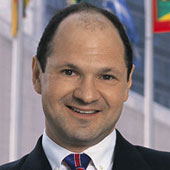New York’s Farcical Blackout?
Was the Blackout of 2003 a repeat of the 9/11 tragedy and the Blackout of 1977?
August 24, 2003
When lights and computer screens flickered and went out at 4:10 p.m. on Thursday, August 14, 2003, many New Yorkers felt a sense of déjà vu. In their memories, they were transported to that day almost two years ago when another — much more tragic — event disrupted their usual work day.
Just as on September 11, 2001, office buildings in Manhattan spilled crowds of people on the sidewalks. There, they stood around trying to figure out what was going on and trading rumors.
Before long, they started heading home, with many people walking on the streets — thus worsening already awful traffic jams.
And just as two years ago, telephones were not working and cell phones were overloaded. As a result, most people had no way to communicate with their families and friends.
Although rumors blaming terrorists for the largest blackout in U.S. history began circulating early, most New Yorkers did not seem to believe them.
Many residents chose to reach deeper into in the city’s collective memory. They recalled the infamous blackout of 1977, when power similarly disappeared for a couple of days in the summer. Back then, the city had immediately exploded in an orgy of violence, rioting and looting.
Not this time, however. First of all, New York has become much more gentrified over the past quarter of a century. On the Upper West Side, for example, the scene of major looting in 1977, there are now only very few poor people — mainly concentrated in housing projects.
The rest of the neighborhood has become an extremely desirable place to live for middle-class professionals. Meanwhile, all and those who couldn’t afford the sky-high rents have been pushed out.
But even in the outer boroughs, the police presence was very noticeable. Even in the worst of the notorious New York City ghettos, the South Bronx, police cruisers patrolled virtually every street. The city deployed some 10,000 extra police officers to direct traffic and to make sure there was no mischief.
Calm prevailed and city officials patted themselves on the back for being well prepared this time.
So, was Marx wrong? Was this double déjà vu of September 11 and the blackout of 1977 not a farce but a story with a Hollywood happy ending? Or a morality play showing how good government helps people overcome emergencies?
Not exactly. What struck many people in New York City were the many inaccuracies that pervaded official statements about the blackout — as well as media and television reports.
Public officials, of course, always want to put a good spin on the situation — and demonstrate to their constituents that they are always in control.
It is understandable that one would want to give public officials the benefit of the doubt as they deal with a confused situation. But it is the job of the media not just to report what officials say — but also to investigate whether it reflects the situation on the ground.
Just as they did on September 11 two years ago, radio and television channels dropped their usual programming and dedicated their broadcasts entirely to covering on the blackout.
This was a welcome public service for an anxious public waiting to learn more. Unfortunately, though, it appeared as if the media were not to worried about whether or not officials were embellishing the truth.
As a result, information provided to the public by officials was often confusing and misleading — and in most cases went uncorrected by the media.
For example, in the afternoon of August 15, the second day of the blackout, radio stations reported that lights were on in Manhattan below 42nd street.
In reality, most downtown neighborhoods — including Chelsea, East Village and Chinatown — didn’t get power restored until much later that evening.
City officials also indicated on the second day of the blackout that the airports had reopened — and that flights had resumed. In reality, passengers were stranded without food or water — or, for that matter, information as to what they were to expect.
Some passengers even asked reporters to correct the disinformation they saw pouring from airport TV screen as they were frantically searching for informed officials.
Similarly, despite New York Mayor Michael Bloomberg’s assurances that crime went down on the day of the blackout, it turned out that the police arrested nearly 1,000 people, one third of them for looting.
So the rosy scenario of a city enveloped by a warm and fuzzy spirit of communality — as the favorite storyline of the media and officials went — turned out not to be the entire truth.
But as far as the blackout is concerned, the echoes of the Iraq war don’t end with the media coverage.
Even though it eventually came out that the power failure originated in Ohio, New York officials were quick to criticize Canadian power suppliers — and hinted at the possibility of reviewing the commercial relationship with them.
True, their mistake was understandable, since the power failure, having looped the Great Lakes, came to New York from the north.
But the readiness to blame foreigners or outsiders — and, in the case of Canada, a reliable friend and ally — has become a staple government tactic since the Iraq war.
After all, nobody has suggested that the rest of the country should disconnect its grid from Ohio.
So even though the Blackout of 2003 turned out all right for the most part, it revealed some uncomfortable truths about the state of the media and political establishments in the United States.
Read previous
Bollywood Beatbox
August 23, 2003
